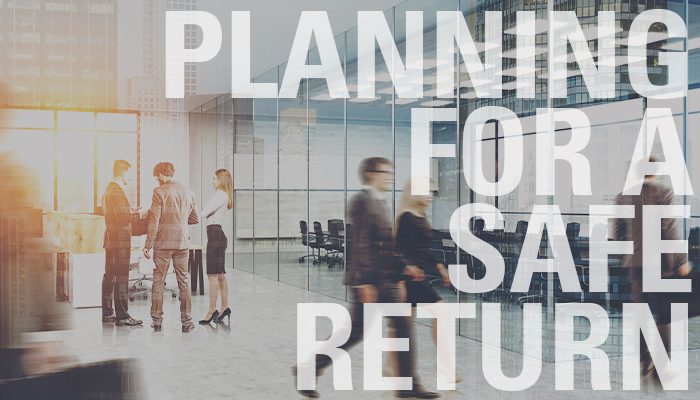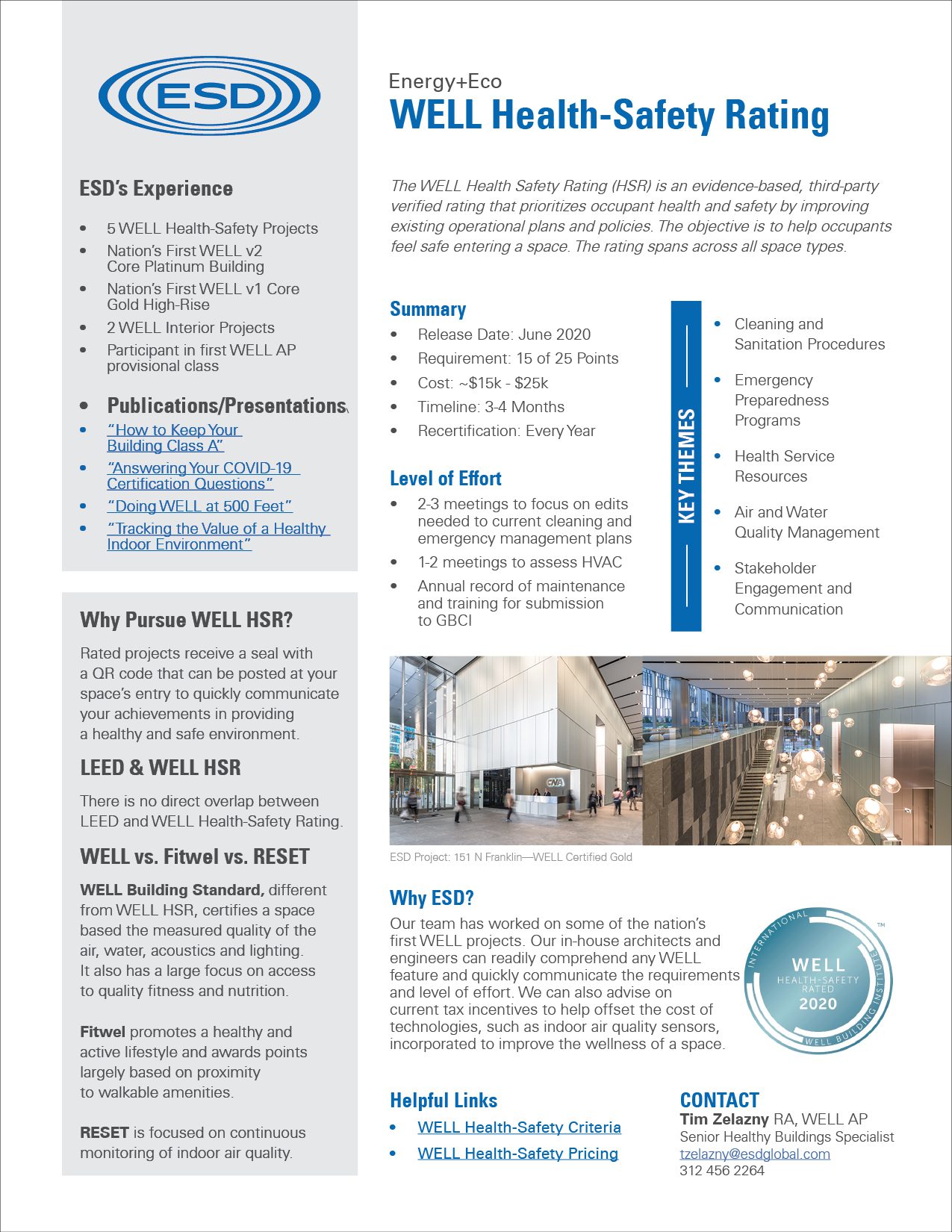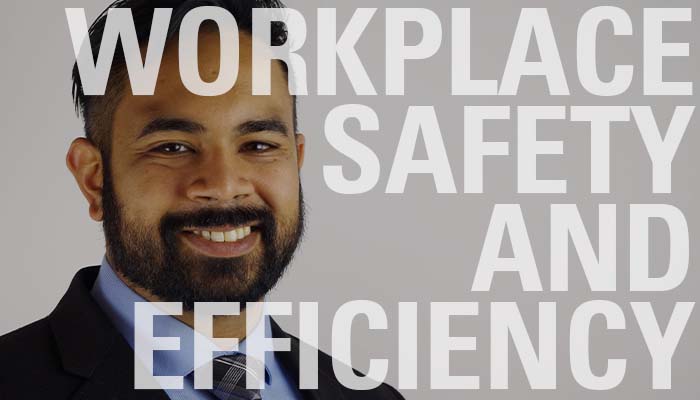ESD plumbing engineer expert explores how smart water systems save resources and protect consumers from pathogens, including those that lead to Legionnaires’ disease. (Read more about intelligent water systems.)
Organizations charting a course through the COVID-19 pandemic and its aftermath are facing one of the largest business challenges of our time.
For over the past year, many companies have adopted new ways to keep operations on track while minimizing risks to employees. For stores and factories with little or no option to work remotely, many businesses were forced to close temporarily, and in some cases permanently, as owners scrambled to put new measures in place to keep facilities operating as safe as possible.
Other businesses were fortunate to be able to switch to a partial or a totally remote workforce relying on interactive technologies to keep teams and clients connected. Zoom meetings and online company celebrations became the norm for many, yet for others there continues to be a void left unfilled because of a lack of in-person communication and collaboration.
The following outlines some important considerations and questions that can help determine your company’s appetite and preparedness for returning to a post-pandemic workplace.
What does “return to office” mean in a new era of “working remotely”?
Before rushing to turn on the lights and throw open the doors to returning office workers, you may want to take the time to determine what kind of space best meets your organization’s needs in a post-pandemic world. For many companies, the trend toward a hybrid-workspace was growing even before COVID-19 hit. The subsequent shutdowns and office closures served as a forced proof statement for many that efficient and productive work from remote locations was indeed possible. That has many organizations reexamining trends that may already have been in motion but are now accelerated.
In general, the spectrum from totally in office to totally remote work can be categorized into five segments:
- Office-Centric: Traditional office/facility environment where employees work together primarily from a central location.
- Office/Hybrid: A central office experiments with creating regional or global office locations as a geographic extension of the main business center.
- Hybrid: A central office begins to formally implement regional/global office policy.
- Hybrid/Remote: Employees primarily work from home/remote locations, while returning to a central office periodically for in-person collaborations, meetings, or events.
- Remote/Virtual: Describes the adoption of a global virtual work model with little or no centralized office settings.
Even before the pandemic, a hybrid office model was already the norm for many businesses. The sudden and forced adoption of a completely remote workforce over the past year has many considering taking another step. While not ready to go completely virtual, some are seeing the benefits of adopting a hybrid/remote model:
- Employee Recruitment/Retention: In an increasingly competitive job market, the opportunity for more flexible work options can be an attractive incentive for employees.
- Reduced Facility Costs: The traditional model of providing a separate desk/space for each employee may no longer be applicable, reducing the floor size needed to be built or rented.
- Environmental Benefits: Smaller facilities accommodating fewer employees will logically use less energy for heating, cooling, and electronic power consumption. Remote workers may also have a positive impact on the environment by reducing the amount of carbon emissions that would have been emitted during a daily commute to the office.
Preparing for a return to the office may be the perfect time to consider modifying your existing space. If moving to a hybrid/remote model is an attractive option, this is the time to redesign spaces to better serve the evolving needs of hybrid/remote employees. This can mean:
- Reallocating Workspace: Reduce the number of individual personal spaces to make more areas for group collaborations and team meetings. A system of “hoteling” can be established to allow employees to reserve workspace for days of in-office visits.
- Upgrading Technology: To keep workers and teams connected in a hybrid/remote setting it is vital to have the appropriate hardware and software available to support productivity and seamless interactions.
- Keeping It Human: One of the biggest takeaways from the COVID-19 crisis is that working in an isolated setting is not good for the mental well-being of many individuals. While many self-described introverts readily embraced the new normal for remote working, others found the absence of direct contact with coworkers to be an added strain. Realize that remote work may not be optimal for everyone and exceptions may be advised.
Wherever your organization falls on the return-to-work spectrum, understanding that your physical office space and remote work policies may be due for a reexamination is an important first step. In addition to identifying necessary systems upgrades and workspace redesigns, you can also gain a better understanding of how ready your employees are to return.
What can building owners and managers do to demonstrate offices are safe?
As the world takes steps toward returning to “business as usual,” organizations are scrambling to define exactly what that means. For commercial property owners, it can mean building trust and confidence among returning tenants and office workers. Verified procedures, new technology, and third-party validations can all add up to a new normal for workplace health and safety.
Facility Health and Wellness: The WELL Health-Safety seal is a building certification developed by the International WELL Building Institute and is available to building owners and operators. An ad campaign promoting the rating was launched in early 2021 to raise awareness to help people feel more confident entering offices, stores, schools, restaurants, and more by looking for the WELL Health-Safety Seal.
- In Chicago, ESD assisted with a building attaining the nation’s first WELL Core Certified at the Platinum level designation.
- In 2020, ESD’s Willis Tower headquarters earned the WELL Health-Safety Rating. The designation supplements the company’s previous LEED, Fitwel, and Be Safe Chicago health and wellness certifications.
- Touchless Technologies: Advances in technology make touchless spaces like never before. While sensors on restroom faucets and hand-dryers are fairly ubiquitous today, smart buildings are quickly catching up. These facilities can include a building automation system (BAS) that combines hardware and software into an intelligent system. Automation is being applied to everything from heating, venting, and air conditioning (HVAC) systems to elevators, automated entries, lighting controls, security cameras, television monitors, and more. While touchless technologies can mitigate the surface contact transmission of harmful microbes, building owners and operators are warned to be wary of a different type of infection: computer viruses. As operational technology (OT) and information technology (IT) begin to merge, cybercriminals are exploiting the vulnerabilities of interconnected smart devices. When going touchless, businesses are warned to do so safely by fully understanding possible cybersecurity risks.
- Indoor Air Quality: In the wake of COVID-19, building tenants are more attuned to their indoor environment. Returning office workers may be seeking higher performing heating, ventilation, and air conditioning (HVAC) systems that prioritize indoor air quality (IAQ) and enhance occupant health, safety, and wellness. In response, building owners are targeting IAQ performance and HVAC system flexibility as differentiating factors for addressing office reopening concerns. Real-time monitoring of IAQ can literally be put in the hands of tenants using smart phones to check readings. The impact of the COVID-19 pandemic on building design and strategy will likely be revolutionary, influencing post-pandemic HVAC strategies for both existing and future office spaces for years to come.
Safety first!
Until now, management teams have been largely focused on navigating their organizations through a historic and unchartered period of disruption. As COVID-19 vaccines continue to roll out, the world appears to be ready to take some cautious steps toward returning to “normal,” though that term will likely differ from a pre-pandemic definition. Now the task facing business leaders is determining how and/or when to start the complicated task of returning to the workplace once restrictions are lifted.
It would be great if there was a magic switch that could be thrown that officially ends this crisis. Unfortunately, a more gradual return to some semblance of business-as-usual is more likely. That leaves companies with the moral, ethical, and legal responsibility to make health and safety the number one consideration when deciding on the best plan for reopening of offices.
Here are some considerations for fostering a safe and compliant return:
- Know the law: Federal, state, and local restrictions and regulations vary widely across the country. It is unlikely these measures will be relaxed uniformly from region to region. Business leaders should plan for a range of scenarios based on where different work takes place.
- Establish new protocols: The reopened office space may need to be rearranged to create a safer workstation layout that keeps employees farther apart. Schedules may be adjusted to reduce the number of people in the space at any one time. New contactless entries and water faucets can be installed. Finally, companies may require new routines for sanitation and deep cleaning.
- Promote good hygiene: Decreasing the spread of COVID-19 and other communicable diseases can be achieved by practicing good hygiene at work and at home. Employees should be encouraged to wash hands for at least 20 seconds periodically throughout the day with soap and warm water. When applicable, sanitizer and disinfecting wipes should be available. Coughs and sneezes should be covered, and personal face coverings should be worn, especially when social distancing of six feet is not possible. The World Health Organization (WHO) offers other guidelines to protect you and others from this disease.
- Follow CDC and medical professional guidelines: The Centers for Disease Control and Prevention (CDC) regularly provides recommendations on how to safely mitigate the spread of this disease. Advice from local health and medical professionals should also be considered when developing a back-to-work plan.
What questions should I be asking when developing an office reopening strategy?
The short answer is—it depends. What may work for your organization may not for others. For every company, however, the real question isn’t when should we reopen but rather how should we reopen? There is no playbook to turn to for a definitive plan, but there are questions everyone can ask to help guide decisions:
- Which roles transitioned smoothly to remote working? When trying to stage a scaled return to the office plan, it may make sense to allow employees with little loss of job productivity to continue to work remotely for a period of time. This could reduce headcount in the office initially and make it easier to social distance and maintain health protocols.
- Are there jobs that must be onsite to succeed? There was a time when historically “face-to-face” jobs, such as those in relationship management, human resources, and sales, were deemed too hands-on to be successfully done remotely. Many have learned over the past year that those rules are changing. Even the need for travel is being reevaluated in a post-pandemic world. While some roles will continue to work best in-person, others may not. A careful, honest assessment of job requirements could be in order.
- Is adopting a “hybrid” return to office plan an option? Carefully coordinating teams can make a partial return to the office a viable choice. There is little doubt that the traditional office setting can help build a company’s culture in ways that are more difficult to promote from a distance. Bringing back teams of employees, even on a limited basis, can have a major impact of morale and company spirit. Individuals who likely never see each other in a meeting room may form bonds in the company breakroom. In the near term, bringing back employees on a staggered schedule (e.g.—half return Monday and Tuesday, the other half Thursday and Friday, and everyone remote on Wednesday) could garner some of the in-person benefits lost during pandemic lockdowns.
How do I help employees transition back to the office?
Without the support of employees, even the best-made plans are likely to run into problems. Remember, this pandemic has impacted individuals in many different ways. When designing a post-COVID-19 return to office plan, managers should remember to:
- Lead with empathy: Taking the time to understand specific challenges and feelings can go a long way toward earning employee support for returning to the office. Some may be eager to directly reconnect with colleagues yet continue to face caregiving responsibilities at home making a return difficult. Others may have underlying health conditions that put them at greater risk of serious COVID-19 infection, making them more hesitant to return to the office. Still, others may have discovered that they are more introverted and tend to work more productively from a remote setting. Demonstrating an understanding of the different life factors involved in re-entering the workplace is an important step to earning employee confidence and trust.
- Gauge employee appetite for returning to the office: A simple survey can be a great way to get a better idea about how employees are feeling about returning to work. It also demonstrates a company’s willingness to navigate and coordinate this complex process with the people it directly impacts. While a specific survey should be crafted to address unique situations, here are some basic questions to include:
- Are you looking forward to returning to work?
- If working remotely is an option, would you prefer to do so?
- How would you rate your productivity while working remotely?
- Are you concerned about commuting to work?
- Are you concerned about the continued threat of COVID-19?
- What steps can the company take to make you more comfortable about the safety of returning to work?
- Are you willing to work a flexible schedule?
- Are you confident the appropriate safety measures are being taken to support a safe return???????
- Of course, an actual survey can be much more specific to evaluate precautions taken, safety protocols established, staggered return options considered, and other issues specific to a particular business. Whether or not everyone endorses the final return to office plan set in motion, taking the time to solicit and truly consider individual concerns can earn employee trust and offer them a sense of empowerment.
- Maintain a consistent communication strategy: Regular and transparent communications with employees is an essential part of any office reentry plan. This can include periodic virtual town hall meetings or fireside-type chats with the CEO as well as email status updates from a committee formed to plan the transition. Without real information, speculation and rumors can derail productivity and company spirit.
Ready… Set… Go!
Finally, remember that any plan for returning to the office should be approached as a marathon, not a sprint. Careful, thoughtful, and deliberate consideration of this complex task can help you and your organization win the race. When and how organizations bring workers back could have a long-lasting impact for their business as well as office culture. Understanding both the risks and the opportunities can help guide the successful implementation of a return to workplace strategy.
Check out Crain’s Chicago Business article, “Roundtable on Workplace Re-occupancy: For Owners, Landlords and Tenants.”
Want to know more about how ESD can help you and your building or workplace? Please reach out to Mo Fahim or Julie Lardenoit.


 Facility Health and Wellness: The WELL Health-Safety seal is a building certification developed by the
Facility Health and Wellness: The WELL Health-Safety seal is a building certification developed by the 

